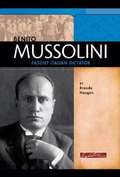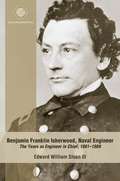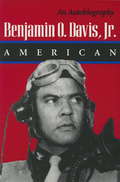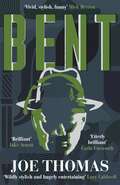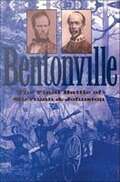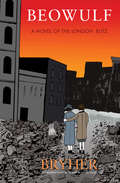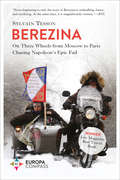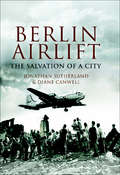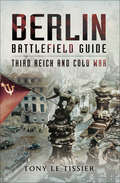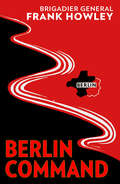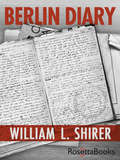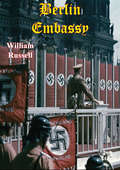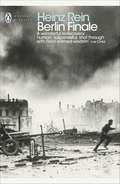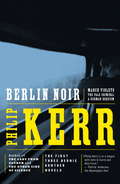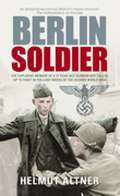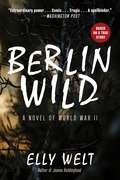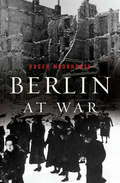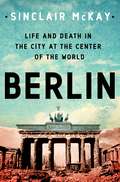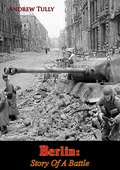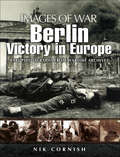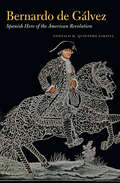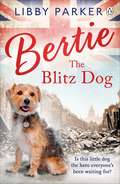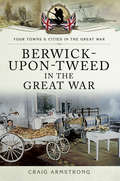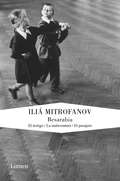- Table View
- List View
Benito Mussolini: Fascist Italian Dictator
by Brenda HaugenFrom 1900 to the present day, humanity and the world have undergone major changes. Drastic shifts in theories and practice tested the standards of personal freedoms and religious conventions as well as science, technology, and industry. The new mind-set of the modern world includes a focus on humanitarianism and the belief that a global economy has made the world a more connected place. Starting as a fascist newspaper editor in the early 1900s, Benito Mussolini rallied enough support to become prime minister of Italy in 1922. He would go on to lead Italy into World War II and befriend Adolf Hitler, the Nazi leader of Germany. Even with the help of his powerful ally, Mussolini's war efforts would not succeed. Mussolini resigned from power and was executed by his own countrymen
Benjamin Franklin Isherwood, Naval Engineer
by Edward William Sloan IIIA classic account of the 40-year Naval career of Benjamin Franklin Isherwood, whose contributions to Naval engineering helped usher in the development of the modern American Navy. Focusing on the years during and immediately after the Civil War, this study chronicles the extensive contributions made by Isherwood in expanding the size and scope of the U.S. Navy.
Benjamin O. Davis, Jr.: American
by Benjamin O. DavisSet against the backdrop of twentieth-century America, against the social fabric of segregation and the broad canvas of foreign war, Benjamin O. Davis, Jr.: American tells a compelling story of personal achievement against formidable odds. Born into an era when potential was measured according to race, Davis was determined to be judged by his character and deeds--to succeed as an American, and not to fail because of color. With twelve million citizens --the black population of the United States--pulling for him, Davis entered West Point in 1932, resolved to become an officer even though official military directives stated that blacks were decidedly inferior, lacking in courage, superstitious, and dominated by moral and character weaknesses. "Silenced" by his peers, for four years spoken to only in the line of duty, David did not falter. He graduated 35th in a class of 276 and requested assignment to the Army Air Corps, then closed to blacks. He went on to lead the 99th Pursuit Squadron and the 332nd Fighter Group--units known today as the Tuskegee Airmen--into air combat over North Africa and Italy during World War II. His performance, and that of his men, enabled the Air Force to integrate years before civilian society confronted segregation. Thereafter, in a distinguished career in the Far East, Europe, and the United States, Davis commanded both black and white units. Davis's story is interwoven with often painful accounts of the discrimination he and his wife, Agatha, endured as a fact of American military and civilian life. Traveling across the country, unable to find food and lodging, they were often forced to make their way nonstop. Once on base, they were denied use of clubs and, in the early days, were never allowed to attend social activities. Though on-base problems were solved by President Truman's integration of the military in 1949, conditions in the civilian community continued, eased but not erased by enactment of President Johnson's legislative program in the 1960s. Overseas, however, where relations were unfettered by racism, the Davises enjoyed numerous friendships within the military and with such foreign dignitaries as President and Madame Chiang Kai-shek. Benjamin O. Davis, Jr., retired in 1970 as a three-star general. His autobiography, capturing the fortitude and spirit with which he and his wife met the pettiness of segregation, bears out Davis's conviction that discrimination--both within the military and in American society--reflects neither this nation's ideals nor the best use of its human resources.
Bent
by Joe ThomasGuardian Best Book of 2020 Irish Times Best Crime Fiction of 2020 Times Book of the Month Mail on Sunday Thriller of the Month The Spectator Crime Fiction of the Month Crime Time Book of the Year 2020 'Vivid, stylish, funny' Mick Heron The first time I met Harold Challenor, he frisked me for weapons - I was ten years old. Bent is the explosive story of the rise and fall of SAS commando, and notorious Detective Sergeant, Harold 'Tanky' Challenor. During the Second World War, Challenor was parachuted behind enemy lines into Italy and France, performing remarkable feats of bravery. In the grimy underbelly of 1960s Soho, he was a ferocious and controversial presence, mediating between factions of club owners and racketeers, and cultivating informers. But just how far will he go to break the protection gang that has a grip on his manor? It can be a fine line that divides hero and villain. PRAISE FOR JOE THOMAS 'Brilliant' The Times 'Feverish energy' Guardian 'Wonderfully vivid' Mail on Sunday'Sophisticated, dizzying' GQ'Vivid and visceral' The Times'Superbly realised vivid and atmospheric' Guardian'Original' Mail on Sunday'A stylish, atmospheric treat an inspired blend of David Peace and early Pinter' Irish Times 'Sparse, energetic, fragmented prose' The Spectator 'Vibrant, colourful, and complex' Irish Independent 'Stylish, sharp-witted, taut. A must for modern noir fans' NB Magazine 'Definitive confident and energetic' Crime Time 'Brilliant manic energy' Jake Arnott 'Wildly stylish and hugely entertaining' Lucy Caldwell 'Vivid, stylish, funny' Mick Herron 'Gripping, fast-paced, darkly atmospheric' Susanna Jones 'Snappy, thoughtful, moving' John King 'Exciting, fresh, incredibly assured' Stav Sherez 'Happy days!' Mark Timlin 'Utterly brilliant' Cathi Unsworth 'Had James Ellroy and David Peace collaborated on a novel they'd have written something like this' Paul Willets
Bentonville
by Nathaniel Cheairs HughesThe battle of Bentonville, the only major Civil War battle fought in North Carolina, was the Confederacy's last attempt to stop the devastating march of William Tecumseh Sherman's army north through the Carolinas. Despite their numerical disadvantage, General Joseph E. Johnston's Confederate forces successfully ambushed one wing of Sherman's army on March 19, 1865 but were soon repulsed. For the Confederates, it was a heroic but futile effort to delay the inevitable: within a month, both Richmond and Raleigh had fallen, and Lee had surrendered. Nathaniel Hughes offers a full-length tactical study of the battle of Bentonville, the only major Civil War battle fought in North Carolina and the Confederacy's last attempt to stop the devastating march of Sherman's army north through the Carolinas. In careful detail, Hughes lays out Confederate and Union troop movements and places the engagement within the larger military framework of the last months of the war. Analyzing the reasons for the initial success and eventual failure of General Joseph E. Johnston's offensive, Hughes maintains that Sherman showed great restraint by remaining committed to the larger goal of reaching Goldsboro rather than stopping to pursue or destroy the defeated Confederates. -->
Beowulf: A Novel of the London Blitz
by BryherEighty years ago, the city of London became the target of a relentless bombing campaign by Nazi Germany during WWII that has come to be known as the Blitz. From the period between 1940-1945, over 20,000 Londoners were killed and half a million lost their homes. Bryher, who lived through a good part of those years in London, has provided us with an indelible portrait of day-to-day life from a variety of voices and perspectives from its regular citizens, humanizing the political backdrop of war with their pluck, humor, endurance, and courage. Her two female protagonists who own and operate the local teashop,The Warming Pan, become the heroes of the novel as they work to provide food and hospitality to the embattled community. The Beowulf of the title, far from the epic hero of the fundamental Anglo Saxon legend, is the name of the teashop's mascot: a plaster sculpture of a bulldog that they discover in the rubble after a heavy bombing raid that they make the centerpiece of their cafe. It becomes a symbol in turn for the fortitude and patient suffering of those innocent civilians caught in the maelstrom of war. Certain to appeal to all fans of WWII fiction, Beowulf is an unforgettable reminder of what it was like during that crucial time in Britain's and the world's history.
Berezina: On Three Wheels from Moscow to Paris Chasing Napoleon's Epic Fail
by Sylvain Tesson“Hilarious, introspective, contemplative, professorial . . . the tale of a historical motorcycle tour quite unlike most any you will ever read.” —Ultimate MotorcyclingLire Magazine Best Travel BookTake four friends, put them on two Ural motorcycles (complete with sidecars), send them off on a 2,500-mile odyssey retracing history’s most famous retreat, add what some might consider an excessive amount of Vodka, and you’ve got Sylvain Tesson’s Berezina, a riotous and erudite book that combines travel, history, comradery, and adventure.The retreat of Napoleon’s Grande Armée from Russia culminated, after a humiliating loss, with the crossing of the River Berezina, a word that henceforth became synonymous with unmitigated disaster for the French and national pride for the Russians. Two hundred years after this battle, Sylvain Tesson and his friends retrace Napoleon’s retreat, along the way reflecting on the lessons of history, the meaning of defeat, and the realities of contemporary Europe. A great read for history buffs and for anyone who has ever dreamed of an adventure that is out of the ordinary.“Wonderfully mad.” —The Times“The narration is wry and marked by a cheerful fatalism. Mr. Tesson is a witty and knowledgeable road companion.” —The Wall Street Journal“From beginning to end, the story of Berezina is enthralling, funny, and terrifying. At the same time, it is magnificently written.” —RTL“Berezina succeeds brilliantly as a sly commentary on—and a challenge to conventional thinking about—today’s contention between Russia and the EU, and the rutted habits of the popular Western mind.” —On the Seawall
Berlin Airlift: The Salvation Of A City
by Jon SutherlandIn June 1948, Joseph Stalin halted all road and rail traffic in to and out of the Allied sector of Berlin and cut off all electricity to the city. The only route into Berlin was by means of three twenty-mile-wide air corridors across the Soviet zone of Germany. Thus the wartime allies of Britain, France and the USA realized that the only option open to them was to supply the beleaguered West Berlin by air transport and so started one of the most dramatic events of the twentieth century. The airlift started in June, 1948. At the beginning there were three loading airfields: Rhein Main and Wiesbaden in the American zone, and Weinstorf in the British zone. By September of 1948 the airlift was transporting a massive tonnage of supplies into Berlin, including coal, food, medical supplies and all the other necessities of life. A mixed fleet of aircraft plodded their endless path to and from the city. Both Ex-planes and pilots were dragged out of retirement. In September 1948 the Russian military threatened to force down western aircraft if they flew outside the 20-mile wide corridors but by March 1949 a total of 45,683 tons of supplies per week were being flown into Berlin. In April Russia finally announced her intention to end the blockade.
Berlin Battlefield Guide: Third Reich & Cold War
by Tony Le TissierA comprehensive look at World War II battle sites in the German capital. On April 16, 1945, the Red Army unleashed a colossal offensive against Berlin with the aim of destroying Hitler&’s armies in the East and capturing the German capital before the Western Allies. Over two million soldiers confronted each other in the last act in the war against Nazi Germany. In the course of the next three weeks, relentless Soviet assaults crashed against a desperate, sometimes suicidal defense, and the historic city was turned into a vast battleground. This was the climax of an awful conflict. It represented the death struggle of Hitler&’s Third Reich and the supreme achievement of Stalin&’s forces, and the story of the battle has fascinated students of warfare ever since. Yet this epic contest can only be understood by visiting the sites of the battle on the ground, on the outskirts of the city, in the suburbs, in the city center where the final dramatic combat took place. And this is the aim of Tony Le Tissier&’s definitive guide to the Battle of Berlin.
Berlin Command
by Frank L. HowleyBerlin Command, first published in 1950, is Brig. General Frank Howley's account of his four-year tenure in post-World War II Berlin with the U.S. Military Government. Filled with stories of Soviet complicity in undermining Allied efforts to rebuild the city, the book is throughout a testament to the ideals of freedom and democracy and the American determination to remain in Berlin, even though surrounded by a hostile opponent willing to lie, cheat, kidnap, rape, and steal to achieve its ends. Howley oversaw Allied efforts to counter the Soviets, and was instrumental in organizing massive airlifts of food, heating fuel, and other supplies that meant survival for the hungry, cold Berliners. General Howley was an unsung hero of the early Cold War period, and Berlin Command is a fascinating account of this historic period when Europe's fate was still being decided.
Berlin Diary: The Journal Of A Foreign Correspondent, 1934-1941
by William L. ShirerThe author of the international bestseller The Rise and Fall of the Third Reich offers a personal account of life in Nazi Germany at the start of WWII. By the late 1930s, Adolf Hitler, Führer of the Nazi Party, had consolidated power in Germany and was leading the world into war. A young foreign correspondent was on hand to bear witness. More than two decades prior to the publication of his acclaimed history, The Rise and Fall of the Third Reich, William L. Shirer was a journalist stationed in Berlin. During his years in the Nazi capital, he kept a daily personal diary, scrupulously recording everything he heard and saw before being forced to flee the country in 1940. Berlin Diary is Shirer&’s first-hand account of the momentous events that shook the world in the mid-twentieth century, from the annexation of Austria and Czechoslovakia to the fall of Poland and France. A remarkable personal memoir of an extraordinary time, it chronicles the author&’s thoughts and experiences while living in the shadow of the Nazi beast. Shirer recalls the surreal spectacles of the Nuremberg rallies, the terror of the late-night bombing raids, and his encounters with members of the German high command while he was risking his life to report to the world on the atrocities of a genocidal regime. At once powerful, engrossing, and edifying, William L. Shirer&’s Berlin Diary is an essential historical record that illuminates one of the darkest periods in human civilization.
Berlin Embassy
by William Russell“First published in 1941 to considerable acclaim, Berlin Embassy is the classic account of the last days of peace in Europe, and has been out-of-print for almost fifty years. William Russell was a young American diplomat working at the US Embassy, in Hermann Goering Strasse, during the grim days of 1939. He had studied in Germany, prior to becoming part of America’s diplomatic mission, which placed him in a position to gain unheard of access to remote areas—both physically and ideologically—of German society during one of the most momentous times in world history. Russell does not miss any opportunity to capitalize on this unique position as he gives a totally absorbing account of both the horror and farce which so often defines such epic times. This quite remarkable account is sure to find a whole new readership.”-Print ed.“Vitally significant and impressive.”—William L. Shirer.
Berlin Finale (Penguin Modern Classics)
by Heinz ReinOne of the first bestsellers in Germany after the Second World War, Berlin Finale is a breathtaking novel of resistance set against the downfall of the Third ReichApril 1945, the last days of the Nazi regime. While bombs are falling on Berlin, the Gestapo still search for traitors, resistance fighters and deserters. People mistrust each other more than ever. In the midst of chaos, a disparate group - a disillusioned young soldier; a trade unionist and saboteur; a doctor helping refugees - continues to fight back. And in Oskar Klose's pub, the resistance plan their next move, hunted at every step by the SS. Published in the immediate aftermath of the Second World War, Berlin Finale is an unforgettable portrait of life in a city devastated by war.Translated by Shaun Whiteside
Berlin Noir: March Violets; The Pale Criminal; A German Requiem (Crime, Penguin)
by Philip KerrIn BERLIN NOIR, Philip Kerr's first three Bernie Gunther novels - MARCH VIOLETS, THE PALE CRIMINAL, A GERMAN REQUIEM -- are compiled in one volume, the perfect introduction to the "best crime series around today" (The Daily Beast).Ex-policeman Bernie Gunther thought he'd seen everything on the streets of 1930s Berlin. But then he went freelance, and each case he tackled sucked him further into the grisly excesses of Nazi subculture. And even after the war, amidst the decayed, imperial splendour of Vienna, Bernie uncovered a legacy that made the wartime atrocities look lily-white in comparison...From the Trade Paperback edition.
Berlin Soldier: The Explosive Memoir of a 12 Year-old German Boy Called Up to Fight in the Last Weeks of the Second World War
by Helmut Altner Tony TissierThis book is an explosive memoir of a 17 year old German boy called up to fight in the last weeks of the Second World War. This is a teenager's vivid account of his experiences as a conscript during the final desperate weeks of the Third Reich, during which he experienced training immediately behind the front line east of Berlin, was caught up in the massive Soviet assault on Berlin from the Oder, retreated successfully and then took part in the fight for the western suburb of Spandau, where he became one of the only two survivors of his company of seventeen year-olds.
Berlin Wild: A Novel of World War II
by Elly Welt"One of the best I've ever read." —Chicago Tribune "Extraordinary power . . . Comic . . .Tragic . . . A spellbinder." —The Washington Post "Earns four stars . . . A wonderful book . . . Read it, by all means, and give it to a friend." —San Francisco Chronicle "This novel hooks the reader on the first page and does not let go." —USA Today "Pain and laughter . . . The author had the genius to allow comedy to dominate this powerful story of struggle." —The Washington Book Review Dr. Josef Bernhardt, an anesthesiologist on the faculty of medicine at the University of Iowa, has tried his whole life to shut out the events of his youth in Berlin during the 1940s, but one incident in his operating room pulls him right back… It&’s 1943, and sixteen-year-old Josef has been invited to leave his family and take up residence at the Wilhelm Institute of Berlin. Half-Jewish, he is unable to attend his high school due to Nazi laws, but as a mathematical genius, he has gained access to an opportunity that will assumedly spare and support him and eight other &“special cases.&” Though Josef is unable to forget about the war and the unknown fate of his family for the two years the Institute offers him sanity and safety, he and the others manage to discover friendship, love, and generosity within and between each other. They work side by side, under the direction of Professor Avilov (The Chief), on genetic experiments and nuclear research—quietly attempting to sabotage the war that is funding their work. Each day for two years, Josef fears that the dreamlike opportunity he has been dropped into might shatter, and that the nightmare of the genocide and war outside will infiltrate his safe haven.Berlin Wild is based on an astonishingly true story of survival.
Berlin at War: Life And Death In Hitler's Capital, 1939-1945
by Roger MoorhouseBerlin was the city at the very center of World War Two. It was the launching pad for Hitler’s empire, the embodiment of his vision of a "world metropolis. ” Berlin was also the place where Hitler’s Reich would ultimately fall. Berlin suffered more air raids than any other German city and endured the full force of a Soviet siege. In Berlin at War, historian Roger Moorhouse uses diaries, memoirs, and interviews to provide a searing first-hand account of life and death in the Nazi capital--the privations, the hopes and fears, and the nonconformist tradition that saw some Berliners provide underground succour to the city’s remaining Jews. Combining comprehensive research with gripping narrative, Berlin at War is the incredible story of the city--and people--that saw the whole of World War Two.
Berlin: Life and Death in the City at the Center of the World
by Sinclair McKaySinclair McKay's portrait of Berlin from 1919 forward explores the city's broad human history, from the end of the Great War to the Blockade, rise of the Wall, and beyond.Sinclair McKay's Berlin begins by taking readers back to 1919 when the city emerged from the shadows of the Great War to become an extraordinary by-word for modernity—in art, cinema, architecture, industry, science, and politics. He traces the city’s history through the rise of Hitler and the Battle for Berlin which ended in the final conquest of the city in 1945. It was a key moment in modern world history, but beyond the global repercussions lay thousands of individual stories of agony. From the countless women who endured nightmare ordeals at the hands of the Soviet soldiers to the teenage boys fitted with steel helmets too big for their heads and guns too big for their hands, McKay thrusts readers into the human cataclysm that tore down the modernity of the streets and reduced what was once the most sophisticated city on earth to ruins.Amid the destruction, a collective instinct was also at work—a determination to restore not just the rhythms of urban life, but also its fierce creativity. In Berlin today, there is a growing and urgent recognition that the testimonies of the ordinary citizens from 1919 forward should be given more prominence. That the housewives, office clerks, factory workers, and exuberant teenagers who witnessed these years of terrifying—and for some, initially exhilarating—transformation should be heard. Today, the exciting, youthful Berlin we see is patterned with echoes that lean back into that terrible vortex. In this new history of Berlin, Sinclair McKay erases the lines between the generations of Berliners, making their voices heard again to create a compelling, living portrait of life in this city that lay at the center of the world.
Berlin: Story Of A Battle
by Andrew TullyAt the end of World War II, Andrew Tully was one of three Americans allowed to enter Berlin as a guest of a Russian artillery battalion commander. He spent the next seventeen years gathering eyewitness accounts, collecting war diaries and letters, and reading over one hundred books in order to write this gripping and comprehensive account about the fall of Berlin.Originally published in the U.S. in 1963, Berlin: Story of a Battle has also been translated into French, Dutch, Italian and Japanese.
Berlin: Victory in Europe (Images of War)
by Nik CornishIn April and May 1945 the city of Berlin was the site of the final destructive act of the Second World War in Europe. The German capital became a battleground. After three weeks of ruthless fighting against a desperate, sometimes suicidal, defense, the Red Army took the city and crushed the last remaining German armies in the East. This momentous battle and the elaborate preparations for it were recorded in graphic detail by photographers whose images have come down to us today. These images, which give us an unforgettable glimpse into the grim reality of mid-twentieth-century warfare, are the raw material of Nik Cornishs evocative book.Using a rich selection of rare photographs from the Russian archives as well as images from German sources, most of which have not been published before, he traces the course of the entire campaign. The battles fought in East Prussia, eastern Germany and Hungary in particular the assault on Budapest are covered. But the body of his book is devoted to the battle for Berlin itself—the monstrous onslaught launched by Zhukovs armies on the Seelow Heights, the bitter street fighting through the suburbs, then the ultimate confrontation, the merciless room-by-room struggle for the center of the city and the Reichstag.
Bernardo de Gálvez: Spanish Hero of the American Revolution
by Gonzalo M. Quintero SaraviaAlthough Spain was never a formal ally of the United States during the American Revolution, its entry into the war definitively tipped the balance against Britain. Led by Bernardo de Galvez, supreme commander of the Spanish forces in North America, their military campaigns against British settlements on the Mississippi River—and later against Mobile and Pensacola—were crucial in preventing Britain from concentrating all its North American military and naval forces on the fight against George Washington's Continental army. In this first comprehensive biography of Galvez (1746@–86), Gonzalo M. Quintero Saravia assesses the commander's considerable historical impact and expands our understanding of Spain's contribution to the war.A man of both empire and the Enlightenment, as viceroy of New Spain (1785@–86), Galvez was also pivotal in the design and implementation of Spanish colonial reforms, which included the reorganization of Spain's Northern Frontier that brought peace to the region for the duration of the Spanish presence in North America. Extensively researched through Spanish, Mexican, and U.S. archives, Quintero Saravia's portrait of Galvez reveals him as central to the histories of the Revolution and late eighteenth-century America and offers a reinterpretation of the international factors involved in the American War for Independence.
Bertie Ahern Autobiography: The Autobiography
by Bertie AhernBertie Ahern, three times Irish Taoiseach, is often described as an enigma. The Old IRA man's son who delivered peace in Northern Ireland. A working class boy responsible for the Celtic Tiger. The man of faith who ushered in progressive, cosmopolitan secular Ireland. An ardent nationalist admired by European leaders. 'I know 25 per cent of Bertie Ahern', said his finance minister, Charlie McCreevy, 'and that's 24 per cent more than anyone else.'Now in this frank and revealing autobiography, Ahern gives his own account of a remarkable political life and the personal story that accompanies it. He shows the cost to his family of a life played out in the public eye and, for the first time, discloses what really happened in his final weeks in power.Here for the first time is the truth behind the man who is Bertie.Ahern has been at the cutting edge of Irish politics for over three decades. He was first elected to Dáil Éireann in the Fianna Fáil landslide victory in 1977 that saw Jack Lynch returned as Taoiseach. In 1982, Charles Haughey appointed him Government Chief Whip. In volatile political times, he strongly supported Haughey during three challenges to his leadership of Fianna Fáil.In 1987, Bertie Ahern received his first cabinet portfolio as Minister for Labour. It was a time when the Irish economy was in crisis. Ireland had a higher debt per head than Ethiopia or Sudan. Unemployment stood at 16%. Ahern negotiated Ireland's first social partnership agreement, which underpinned economic recovery and put in place the foundations for a period of sustained growth. In 1991, he was appointed Minister for Finance. International commentators first began to refer to 'Ireland's Tiger economy' in this period. When Bertie Ahern left the Department of Finance in late 1994, for the first time in almost 30 years, Ireland had a budget surplus.Bertie Ahern succeeded Albert Reynolds as leader of Fianna Fáil in November 1994. Following the General Election in 1997, he became Ireland's youngest ever Taoiseach. The Ahern Era was a time of unprecedented progress in Irish society. Over the course of his tenure in office, Ireland's economy out-performed that of every other European country. For the first time ever, the number of people in employment in the State reached 2 million.Working closely with Bill Clinton and Tony Blair, Ahern won widespread acclaim for his perseverance and skill in negotiating the Good Friday Agreement, which has provided the political framework for a lasting peace in Northern Ireland.On the international stage, he was a respected figure who enjoyed an acclaimed Presidency of the European Council in 2004. He presided over the completion of the largest ever expansion of the EU and concluded negotiations on a European constitution. He is one of only five visiting statesmen to have addressed both the United States Congress and the Houses of Parliament in Westminster.At home, Ahern enjoyed phenomenal electoral support. He was the first Taoiseach since 1944 to win three successive General Elections.Bertie Ahern resigned on 6th May, 2008. He had served for ten years, ten months and ten days as Taoiseach.
Bertie the Blitz Dog
by Libby ParkerTHE PERFECT HEARTWARMING READ for THE NEW YEAR . . . As bombs rain from the skies, can Bertie the Blitz dog find a safe home? Pampered pooch Bertie's owner has passed away. Cold, alone and scared, he's now a stray on London's streets. With a terrible war on, the city is bombed nightly. While rationing has left people starving. It is a dangerous time to have four legs and no owner. So when Bertie meets one special little boy, he thinks he has a chance to find a new home and happiness amidst the rubble. But Bertie - a small dog with the very big heart - knows it'll take all his courage to keep himself and his new friends safe . . . Hopeful, heart-warming and fun, Bertie the Blitz Dog is perfect for fans of Felix the Railway Cat and The Nightingale Christmas Show, Donna Douglas.
Berwick-Upon-Tweed in the Great War (Your Towns & Cities in the Great War)
by Craig ArmstrongBerwick-upon-Tweed was an important garrison town and regional centre, which, as befit its history, had a strong sense of duty, reflected in its proud martial traditions.During the catastrophic years of 1914-18 many Berwick families found themselves greatly affected by the war. Large numbers of Berwick men volunteered to serve in the forces and many were killed. During the first months of war the local barracks were overwhelmed by the number of men volunteering for the King's Own Scottish Borderers, while a great many Berwick lads served with the Northumberland Fusiliers. Others were less keen to serve and this book considers some of these cases, ranging from hairdressers to farmworkers, who were brought before the military tribunal at Berwick.For many of those left behind the war was a time of worry and hardship. Others saw the business opportunities, and this book includes the telling accounts of the Berwick women who were imprisoned for running brothels, which were used by the many soldiers in the town, along with accounts of petty theft and profiteering. Berwick also suffered from wartime policies and severe shortages and these issues are meticulously analysed throughout with a view to how they affected the people of Berwick. As a port, Berwick witnessed the aftermath of the sinking of merchant vessels and the people of the town were keenly aware of the sacrifices being made. They went to great efforts to provide support for those fighting the war, despite the shortages they themselves were suffering from. These efforts are explained in the book, which is a testimony to the bravery, self-sacrifice and determination of the people of Berwick during the Great War.
Besarabia: El testigo | La malaventura | El pasajero
by Iliá MitrofanovTres novelas cortas que retratan la vida de unos ciudadanos tras la ocupación de sus tierras por los rusos durante la segunda guerra mundial. Besarabia es un fantasma en el mapa de Europa, una tierra repartida ahora entre Moldavia y Ucrania, un país que la Historia se comió a dentelladas, engulléndolo sin compasión. En ese lugar de nadie vivieron un día hombres y mujeres que intentaban hilvanar su vida mientras por las calles desfilaban botas siempre distintas. Ese es el caso de Fiódor Petrovich, el barbero que nos habla en El testigo, un infeliz ingenuamente convencido de que su habilidad con la navaja, el cuidado que ponía en enjabonar a sus clientes, le salvarían de la tragedia de la invasión rusa a principios de los años 40 del siglo pasado. De Fiódor pasamos a Sabina, la protagonista de La malaventura, una rebelde sin casa y sin causa, pero generosa hasta la locura en su entrega a un amor que va más allá de su comprensión del mundo. Y, para acabar, he aquí el gran Semén Stavraki, que llena las páginas de El pasajero: ciudadano de Odessa, buzo de profesión y marido entregado, el hombre cuenta sus desventuras a un compañero imaginario en un viaje hacia el peor de los destinos. Esta trilogía, que hemos querido titular Besarabia en homenaje a un lugar que pudo ser y ya no es, celebra la fuerza de Mitrofanov y un talento capaz de devolver incluso a los fantasmas una dignidad que creían perdida.
